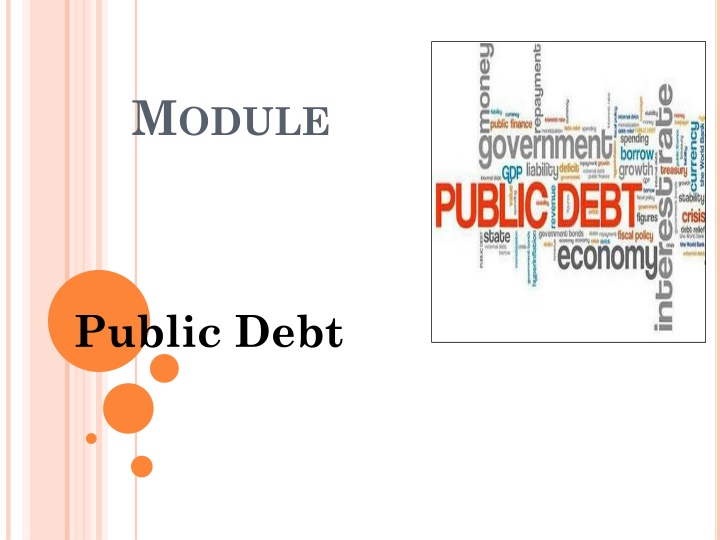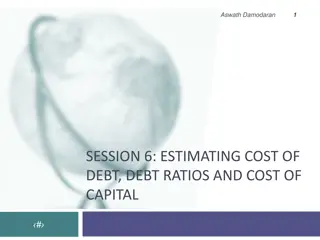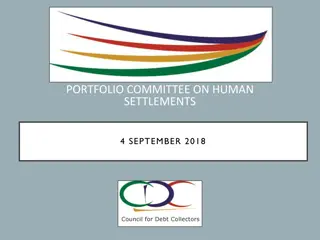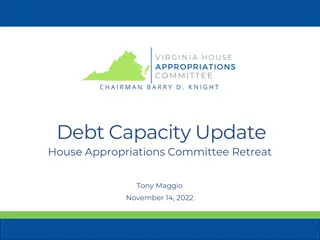Public Debt in India
Public debt in India refers to the debt and liabilities incurred by the Consolidated Fund of India, managed through various financial instruments like bonds, government securities, and T-bills. It plays a crucial role in financing government activities, with different types of debts and debt burdens affecting economic stability and policy decisions.
Download Presentation

Please find below an Image/Link to download the presentation.
The content on the website is provided AS IS for your information and personal use only. It may not be sold, licensed, or shared on other websites without obtaining consent from the author.If you encounter any issues during the download, it is possible that the publisher has removed the file from their server.
You are allowed to download the files provided on this website for personal or commercial use, subject to the condition that they are used lawfully. All files are the property of their respective owners.
The content on the website is provided AS IS for your information and personal use only. It may not be sold, licensed, or shared on other websites without obtaining consent from the author.
E N D
Presentation Transcript
MODULE Public Debt
PUBLIC DEBT Public Debt is the debt and liabilities contracted in the Consolidated Fund of India. It is a stock variable. Whenever a debt obligation is made, the Government needs to acknowledge it through the following primary ways: Bonds Government Securities T-Bills Dated Government Security Cash Management Bills
ROLE OF PUBLIC DEBT Tax Smoothening implies raising of taxes to pay down debt. Debts can directly amplify or transmit shocks & macroeconomic stability. When any Government runs out of funds to finance a war-like situation, it resorts to borrowing to meet such expenses. To finance highly ambitious projects, Government tend to borrow funds. Filing saving and investment gap
TYPES OF DEBTS Productive (yields income to Government) & Unproductive debt (doesn t add to productive assets of a country) Voluntary (no legal enforcement) & Involuntary debt (legally enforced) Internal (loan floated within country) & External debt (loan floated from abroad) Short (<1 year), Medium (1 to 5 year) & Long-term debt (20 to 30 year) Redeemable (raised with intention to pay back) & Irredeemable debt (pay back only interest)
PUBLIC DEBT BURDEN Public debt constitutes the financial obligation or liabilities of the government. Debt Burden = Outstanding Debt/ GNP Another formulation; Debt Burden = (Annual Interest Payments)/ (Aggregate tax revenue) Debt Burden = (Annual interest payments of borrowing)/ (National Income) Types of Public Debt Burden: Internal Debt Burden External Debt Burden
INTERNAL & EXTERNAL PUBLIC DEBT BURDEN Internal Public Debt Burden: Increases inequality: transfers purchasing power from poor to rich. Adversely affects the ability and desire to work, save and invest. Reduces private investment External Public Debt Burden: Direct money burden: measured by debt-service ratio. Direct real burden: Domestic consumption Foreign currency burden ; Private investment Indirect money & real burden also associated.
MANAGEMENT OF PUBLIC DEBT Public Debt Management is the process of establishing and executing a Strategy for managing the government s debt in order to: Raise the required amount of funding Achieve its risk and cost objectives To meet any other debt management goals of the government such as developing and maintaining an efficient market for government securities.
REDEMPTION OF PUBLIC DEBT Refers to escaping from the burden of public debt. Methods: Repudiation: Writing off the loans i.e. not repaying Refunding: Issue of new bonds and securities by the govt. to repay the matured loans. Conversion: Debt with higher interest is converted to a debt of lower interest rate. Capital Levy: Heavy tax on capital assets, property and wealth. Sinking Fund: Accumulating a part of public revenue every year for the repayment of debt. Surplus Budget: (Public revenue - public expenditure) > 0
IMPORTANCE & FRAMEWORK FOR PUBLIC DEBT MANAGEMENT Importance: Helps to reduce the cost of borrowing Helps to develop the domestic financial market Facilitates economic dev. & makes countries less vulnerable to financial risks. Framework: Debt Management objectives Transparency and Accountability Institutional Framework Debt security and Risk Management Efficient Market for Government Securities
PUBLIC DEBT MANAGEMENT POLICY OF GOVERNMENT OF INDIA (GOI) & INSTITUTIONS INVOLVED Debt Management Policy of GoI: Greater reliance on domestic borrowing over external debt Preference for market borrowing over high cost instruments carrying administered interest rate Elongation of maturity profile of its debt portfolio & Consolidation of the debt portfolio Development of deep and wide market for government securities Institutions involved: Reserve bank of India Ministry of Finance, Office of Aid and Account division Ministry of Finance, Budget Division
REFERENCES https://finmin.nic.in/sites/default/files/govt_debt_2012.pdf 2020. The Indian Economy Compendium. Disha Publications https://m.rbi.org.in/Scripts /FAQView.aspx?Id=79. Hull, J. (2012). Options, futures & other derivatives (9th ed.) https://blogs.imf.org/2016/08/26/an-argument-for-paying-down-public-debt/ https://www.oecd.org/economy/monetary/Debt-and-macroeconomic-stability.pdf Froyen, Richard T, Macroeconomics: Theories & Policies https://www.economicsdiscussion.net/debt-2/public-debt-meaning-classification-and-method-of- redemption/17472 https://www.economicsdiscussion.net/debt-2/burden-of-public-debt-and-its-measurement/17464 Tresch R.W., Public Finance: A Normative Theory https://www.imf.org/external/np/mae/pdebt/2000/eng/index.htm https://www.un.org/esa/ffd/wp-content/uploads/2008/04/20080408_Balino-Sundararajan- paper.pdf Shaikh, S. (2010). Business Environment, 2/E (2nd ed.). https://www.rbi.org.in/scripts/FS_Overview.aspx?fn=2757 https://dea.gov.in/divisionbranch/aid-accounts-audit-division https://dea.gov.in/divisionbranch/integrated-finance-division























